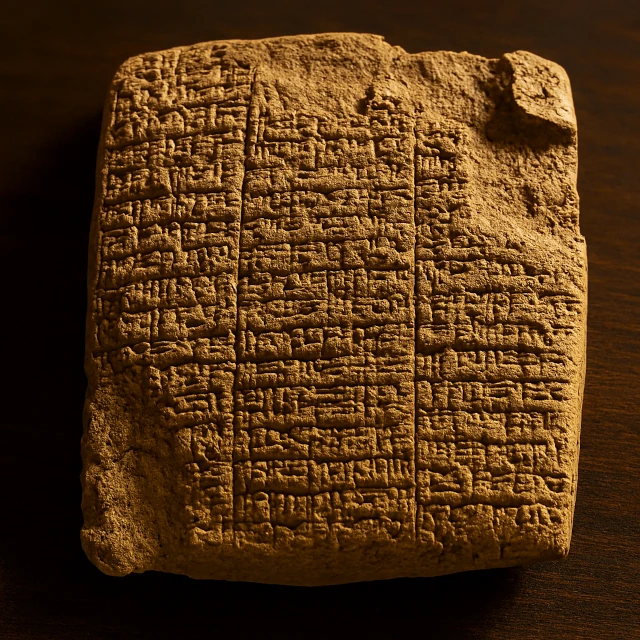
Long before the Greeks or Chinese, the Sumerians and their Babylonian heirs observed the sky from the banks of the Tigris and Euphrates.
From the 3rd millennium BCE, they established the first correlations between celestial movements and earthly events, associating gods with visible stars: Shamash with the Sun, Sîn with the Moon, Ishtar with Venus, Nergal with Mars, Marduk with Jupiter, and Ninurta with Saturn.
This religious astronomy evolved into a remarkably precise mathematical astronomy.
Astronomer-priests (ṭupšar Enūma Anu Enlil) recorded lunar phases, heliacal risings, and eclipses on thousands of clay tablets.
These archives form the first known astronomical database.
Mesopotamian observatories, often located atop ziggurats, served as observation platforms to measure the angular heights of stars using gnomons and sighting tubes.
Babylonian astronomers conducted repeated measurements over centuries, identifying essential periodic cycles such as the Saros cycle of eclipses (≈ 18.03 years).
Their goal was not to understand the physical causes of celestial movements but to determine their regularities to predict the future.
Thus, a primitive form of empirical celestial mechanics was born, where calculation precision prevailed over cosmological speculation.
| Period / Civilization | Approximate Dates | Astronomical Contributions | Instruments and Innovations |
|---|---|---|---|
| Sumerian | c. 3000 – 2000 BCE | Organization of the sky into primitive constellations; identification of the Mesopotamian zodiac with 12 divisions; lunisolar calendar based on the synodic cycle of the Moon (29.53 days). | Use of the gnomon and the agricultural calendar; first star lists (such as the "List of Anu's Stars"). |
| Old Babylonian | c. 1900 – 1000 BCE | Regular observation of lunar eclipses and correlation with political events; emergence of the Enūma Anu Enlil series (7000 celestial omens). | Development of star rise and set tables; first calculations of intercalary months to stabilize the calendar. |
| Neo-Babylonian | c. 1000 – 539 BCE | Emergence of quantitative astronomy; recording of planetary positions; determination of the mean synodic month and ecliptic longitudes. | Introduction of regular observation tablets (astronomical diaries); standardization of the sexagesimal numerical system. |
| Chaldean (Hellenistic period) | 539 – 100 BCE | Development of arithmetical models of planetary movements; invention of the zodiac with 12 signs of 30°; direct influence on Greek astronomy (Hipparchus, Ptolemy). | Use of ephemeris tablets and linear diagrams to represent the variable speeds of planets. |
N.B.:
The Babylonian sexagesimal system (base 60) allowed for great precision in angle and time calculations: \(1° = 60′ = 3600″\).
Our 60-minute hours and 360° circles still derive from this numeration.
N.B.:
The Chaldeans of the 5th century BCE were the first to establish predictive tables for the movements of Jupiter and Venus.
They used arithmetical methods equivalent to discrete integrals, foreshadowing the modern concept of area under a curve.
Babylonian scholars conceived the movement of celestial bodies according to a purely arithmetical logic.
Planetary positions were calculated by adding or subtracting average speeds at regular intervals.
The so-called System A and System B tablets (5th–3rd century BCE) show the use of numerical epicycles even before the Greek geometric formulation.
Some tablets discovered in Sippar and Uruk show that the Babylonians knew a form of discrete differential calculus: they determined the area under a curve representing the variation in Jupiter's speed to estimate its mean longitude, a concept Europe only rediscovered in Newton's time.
The Babylonian calendar combined lunar and solar cycles: a year of 12 months of 29 or 30 days (354 days) with the intercalation of a 13th month to restore seasonal correspondence.
This method was transmitted to the Jews during the Babylonian exile (6th century BCE), giving rise to the Hebrew calendar.
The 12 signs of the zodiac first appeared in Babylon around 450 BCE.
Each sign corresponded to a constellation traversed by the Sun and a deity.
They had proper names in Akkadian or Sumerian, often linked to gods, animals, or agricultural symbols.
These 30° divisions formed the conceptual framework of astrology, later transmitted to the Greeks.
It was the Greeks who, adapting the Babylonian zodiac in the 4th century BCE, created the names we know today (Aries, Taurus, Gemini, Cancer, Leo, Virgo, Libra, Scorpio, Sagittarius, Capricorn, Aquarius, and Pisces).
Babylonian astronomy exerted a decisive influence on ancient Greece.
The works of Hipparchus on the precession of the equinoxes, Geminus, and Ptolemy are directly based on Chaldean data compiled in Babylon and Uruk.
Lunar cycles, synodic periods, and the zodiac division all originate from these Mesopotamian sources.
By combining systematic observation and mathematical analysis, the Babylonians laid the foundations of modern astronomical science.
Their empirical approach, based on periodicity rather than physical cause, constitutes the first form of a predictive model of the natural world.
References:
– Francesca Rochberg, The Heavenly Writing: Divination, Horoscopy, and Astronomy in Mesopotamian Culture, Cambridge University Press (2004).
– Hermann Hunger & David Pingree, Astrological Diaries and Astronomical Texts, Brill (1989–2005).
– Asger Aaboe, Episodes in the Early History of Astronomy, Springer (2001).
– John Steele, Observations and Predictions of Eclipse Times by Early Astronomers, Springer (2000).
– Sachs & Hunger, Astronomical Diaries and Related Texts from Babylonia, Austrian Academy of Sciences (1988–2006).
Babylonian astronomy marks the birth of a science of time based on patient observation and the regularity of phenomena.
By linking the destiny of kingdoms to celestial mechanics, the Babylonians established a continuity between cosmos, power, and mathematics.
Their legacy is found in the measurement of time, the division of the circle, lunar cycles, and the foundations of Western astronomy.